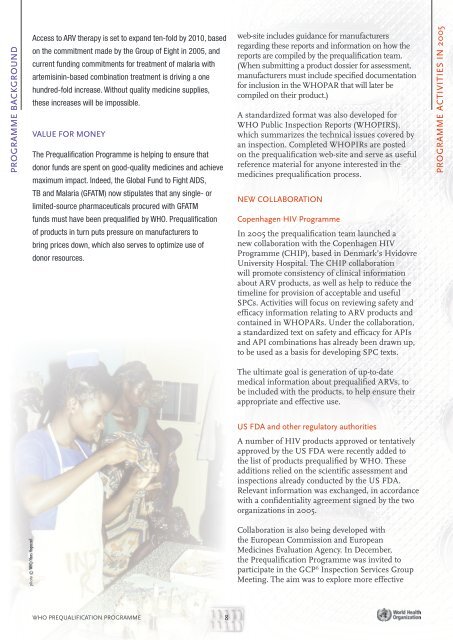WHO PReQuaLiFicatiOn PROgRamme
WHO PReQuaLiFicatiOn PROgRamme
WHO PReQuaLiFicatiOn PROgRamme
Create successful ePaper yourself
Turn your PDF publications into a flip-book with our unique Google optimized e-Paper software.
PROgramme backgroundAccess to ARV therapy is set to expand ten-fold by 2010, basedon the commitment made by the Group of Eight in 2005, andcurrent funding commitments for treatment of malaria withartemisinin-based combination treatment is driving a onehundred-fold increase. Without quality medicine supplies,these increases will be impossible.VALUE FOR MONEYThe Prequalification Programme is helping to ensure thatdonor funds are spent on good-quality medicines and achievemaximum impact. Indeed, the Global Fund to Fight AIDS,TB and Malaria (GFATM) now stipulates that any single- orlimited-source pharmaceuticals procured with GFATMfunds must have been prequalified by <strong>WHO</strong>. Prequalificationof products in turn puts pressure on manufacturers tobring prices down, which also serves to optimize use ofdonor resources.web-site includes guidance for manufacturersregarding these reports and information on how thereports are compiled by the prequalification team.(When submitting a product dossier for assessment,manufacturers must include specified documentationfor inclusion in the <strong>WHO</strong>PAR that will later becompiled on their product.)A standardized format was also developed for<strong>WHO</strong> Public Inspection Reports (<strong>WHO</strong>PIRS),which summarizes the technical issues covered byan inspection. Completed <strong>WHO</strong>PIRs are postedon the prequalification web-site and serve as usefulreference material for anyone interested in themedicines prequalification process.programme activities in 2005NEW COLLABORATIONCopenhagen HIV ProgrammeIn 2005 the prequalification team launched anew collaboration with the Copenhagen HIVProgramme (CHIP), based in Denmark’s HvidovreUniversity Hospital. The CHIP collaborationwill promote consistency of clinical informationabout ARV products, as well as help to reduce thetimeline for provision of acceptable and usefulSPCs. Activities will focus on reviewing safety andefficacy information relating to ARV products andcontained in <strong>WHO</strong>PARs. Under the collaboration,a standardized text on safety and efficacy for APIsand API combinations has already been drawn up,to be used as a basis for developing SPC texts.The ultimate goal is generation of up-to-datemedical information about prequalified ARVs, tobe included with the products, to help ensure theirappropriate and effective use.US FDA and other regulatory authoritiesA number of HIV products approved or tentativelyapproved by the US FDA were recently added tothe list of products prequalified by <strong>WHO</strong>. Theseadditions relied on the scientific assessment andinspections already conducted by the US FDA.Relevant information was exchanged, in accordancewith a confidentiality agreement signed by the twoorganizations in 2005.photo © <strong>WHO</strong>/Hans HogerzeilCollaboration is also being developed withthe European Commission and EuropeanMedicines Evaluation Agency. In December,the Prequalification Programme was invited toparticipate in the GCP 6 Inspection Services GroupMeeting. The aim was to explore more effective<strong>WHO</strong> PREQUALIFICATION PROGRAMME
















